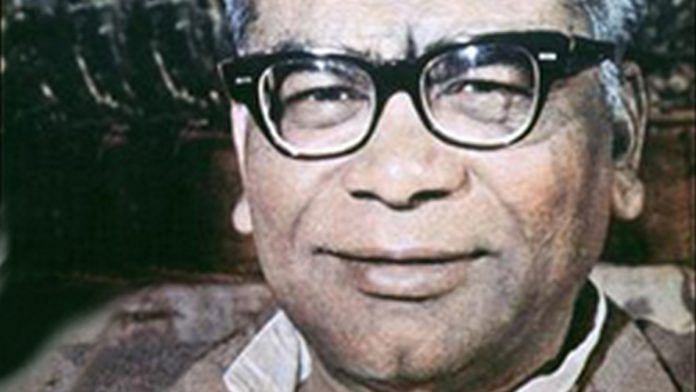Unlike other socialist leaders, Ram Manohar Lohia did not confine himself to the class factor only.
Not just Babasaheb Ambedkar and Mahatma Gandhi, independent India must also carry forward the legacy of a third leader, Ram Manohar Lohia, as an icon of radical struggle for social justice.
As Indian politics is galvanised by SP president Akhilesh Yadav and BSP chief Mayawati getting closer ahead of 2019 Lok Sabha elections, citizens should recall how Ram Manohar Lohia wove social justice with socialism. Lohia’s short life (23 March 1910 – 12 October 1967) acts as a thread that links the stories of Gandhi, Ambedkar and post-1960s politics.
Influenced by Gandhian ideas of civil disobedience, Lohia took an active part in the freedom struggle. That is when Lohia began to independently contemplate the idea of making social change by involving socially backward communities, women, the poor, the peasants, and the working classes in the Independence movement.
Also read: The best known bearers of Ram Manohar Lohia’s philosophy in today’s politics
Lohia’s efforts, along with leaders like Jayaprakash Narayan, Acharya Narendra Dev and others, led to the formation of Congress Socialists, within the Indian National Congress. This group sought to promote socialist ideas in the freedom struggle.
After Gandhi’s assassination in 1948, Ram Manohar Lohia chose to part ways with Jawaharlal Nehru and Sardar Patel, and launched his own party, and focused on the challenge of bringing about social change.
Lohia’s politics in independent India was different. Besides leading the socialist movement, according to scholar Anand Kumar, Lohia’s unique contribution to the political discourse lies in his formulation of an “intersectionalist approach for understanding the inequalities, exclusions and exploitations in the power system of contemporary India”.
Also read: The cruel truth is that Jayaprakash Narayan was let down by his own followers
Unlike other socialist leaders and Communists of that time, Lohia did not confine himself to the most frequently used factor of class. He said that it is the two segregations of caste and gender that have caused unjust social, economic and cultural order in India. In his work The Two Segregations of Caste and Sex, Lohia stated, “All war on poverty is a sham, unless it is, at the same time, a conscious and sustained war on these two segregations”.
Lohia said that destruction of the caste-based hierarchical system was central for democracy to sustain itself. He was angered by then President Rajendra Prasad’s act of publicly bathing the feet of 200 Brahmins in Varanasi and openly criticised him, stating, “To bathe another’s feet publicly is vulgar… To bathe another’s feet on the ground that he is a Brahmin is to guarantee the continuance of the caste system, of poverty and sadness”.
At a time when Nehru was India’s undisputed leader, Lohia contested elections against him in the 1952 general elections to symbolise that no one is infallible and questioned his commitment for social justice by observing, “Aside from general and airy fulminations against the caste system, it would be interesting to know what the Prime Minister has done to smash caste and to encourage fellowship among all”. Lohia’s remarks can be used as a benchmark to measure the commitment of ruling political regimes even today.
His attempt to join hands with Ambedkar in the 1950s was a part of his strategy to develop a broad radical agenda for social justice. Unfortunately, Ambedkar died before the two could meet. Later, in his election speeches, Lohia asked people to reject the “old caste policy” that created a “vertical solidarity of the castes”, and move towards the “new caste policy” of the socialists that sought to bring a “horizontal solidarity” of the Dalits, Adivasis, backwards, religious minorities, women, the working class and the poor people. Years later, BSP founder Kanshiram appeared to have borrowed Lohia’s idea to conceptualise the idea of the Bahujan identity – of horizontal solidarity.
Also read: If Ambedkar & Lohia met- How history missed a crucial moment in social justice politics
The Mandal-OBC politics is the direct impact of Lohia’s socialist movement, which questioned upper-caste dominance and advocated intersectional caste-based affirmative action, including his demand for 60 per cent reservation for the backwards.
Today, while Lohia’s name as a political leader has remained alive because of the efforts of his political followers like Mulayam Singh Yadav and Sharad Yadav, forgotten are Lohia’s ideas, his dialogues with Ambedkar and his concern for Dalits. For instance, the SP opposed the bill for reservation in promotion for SC/ST in Parliament, which was of much concern for the Dalits in 2012.
On the occasion of Lohia’s birth centenary in 2010, political commentator Yogendra Yadav had observed that Lohia’s legacy has been ignored in the same way that Ambedkar’s was before it was revived after his birth centenary. Yadav hoped for a similar revival of Lohia’s legacy.
However, Lohia’s ideas will not be revived until the biases towards his legacy are not removed. Dalit leaders, for whom Ambedkar is an icon, have failed to acknowledge Lohia’s rich legacy and his efforts to launch a common struggle for social justice.
The author is an LLM student at Harvard Law School. He tweets at @anuragbhaskar_ .




Lohia lost to nehru in 1962 general elections and not in 1952.Give us proper information
Lohia contested elections against NEHRU in the 1962 general elections not in 1952.